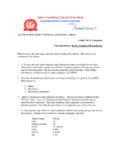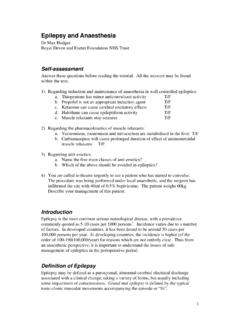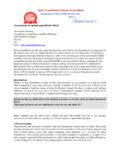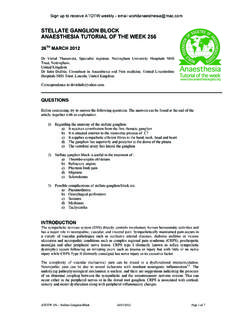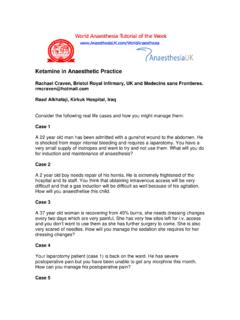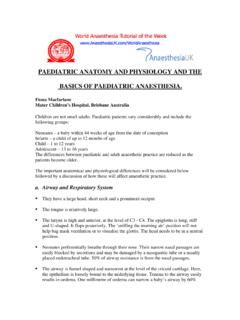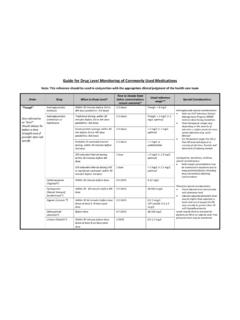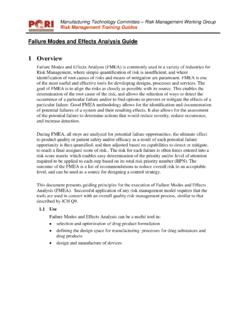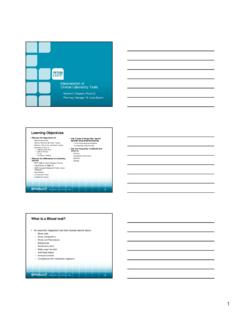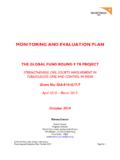Transcription of Anaesthesia Monitoring Techniques
1 2002 The Medicine Publishing Company Ltd477 PHYSICSANAESTHESIA AND INTENSIVE CARE MEDICINED epth of anaesthesiaMost anaesthetics are given without Monitoring the effect of the anaesthetic on the target organ. Depending on the stimulus, there is a depth of Anaesthesia at which the patient becomes aware. The incidence of awareness or recall during general Anaesthesia is about 1/500. Historical methods Clinical assessment uses autonomic signs such as pulse, blood pressure, sweating and lacrimation to predict anaesthetic depth. However, autonomic functions are not affected by depth of Anaesthesia only, and patients with autonomic neuropathy will not react as predicted.
2 Tourniquet Tunstall described inflating a tourniquet to the upper arm above systolic pressure before induction of Anaesthesia . This prevents neuromuscular agents reaching the forearm muscles, and the patient s arm moves if Anaesthesia is too light. This method is unsuitable for routine use because it indicates awareness once it has occurred, and the time for which the tourniquet can be inflated is limited by neuronal ischaemia from (EEG)Recording the electrical activity of the brain provides information on depth of Anaesthesia . However, the equipment is expensive and skilled operators are required to obtain useful information.
3 Different drugs have varying effects on the EEG. Hypotension, hypoxia, metabolic encephalopathy and cerebral oedema can all depress EEG signal output. The EEG detects voltages of 1 500 v. It comprises , , and waves. With increasing depth of Anaesthesia there is a progressive increase in signal amplitude and a reduced frequency (burst suppression). The EEG is non-invasive and presents cortical electrical activity derived from summated excitatory and inhibitory postsynaptic activity that is paced by subthalamic nuclei. Fourier analysis is used to separate the raw EEG into a number of component sine waves.
4 The derived parameters, spectral edge frequency and median frequency describe the entire EEG as a single value. Spectral edge frequency is a single value representing the frequency below which 95% of the total power is present. The median frequency is the point at which 50% of the power lies above and below this value. Median frequency has been shown to control closed loop feedback of intravenous drug administration, but no studies have demonstrated the usefulness of spectral edge index (BIS) is a derived variable that uses informa-tion on EEG power and frequency, and includes information derived from the mathematical technique of bispectral analysis(Figure 1).
5 BIS records a state of the brain and not the effect of a particular drug. BIS gives a numerical value and the data are generated over 30 EEG recordings, with the average updated every 2 5 s. A low BIS value indicates hypnosis. BIS decreases during natural sleep, though not to the level produced by anaesthetic drugs. Evoked potentialsCortical evoked potentials to auditory, visual or somatosensory stimuli are suppressed in a dose-dependent manner by anaesthetic agents, and correlate well with peroperative wakefulness, awareness and explicit and implicit memory. Voltage potentials are small (1 2 v) compared with background electrical activity (> 100 v).
6 Evoked potentials are generated using repeated stimuli, and the electrical responses pre- and post-stimuli are averaged so that only the electrical activity corresponding to the generated stimulus is analysed. The evoked response is divided into early, mid-latency and late cortical waves. Early waves originate in the brainstem and are unchanged by Anaesthesia . Mid-latency waves (40 60 ms post-stimulus) are highly influenced by increasing depth of Anaesthesia , particularly the Pa and Nb waves. Anaesthetic agents increase latency and decrease amplitude in a dose-dependent manner.
7 The correlation of mid-latency auditory evoked potentials to depth of Anaesthesia approaches that of BIS. The late cortical response (50 100 ms post-stimuli) reflects activation of the frontal cortex but is heavily influenced by attention, sleep and sedation. Simon Hughes is an RAF Anaesthetic SHO currently working at the Nuffield Department of Anaesthesia , Griffiths is Consultant Anaesthetist at Peterborough District Hospital. He qualified from St Thomas Hospital, London, and trained in Anaesthesia in Nottingham, Leicester and San Francisco. His main interests are vascular Anaesthesia and medical Monitoring TechniquesSimon HughesRichard Griffiths1 Bispectral index (BIS) monitor.
8 A Electrodes. b Display screen showing digital and analogue recording of BIS. Photograph courtesy of Aspect Medical System 2002 The Medicine Publishing Company Ltd478 Anaesthesia AND INTENSIVE CARE MEDICINE 2002 The Medicine Publishing Company Ltd479 PHYSICSANAESTHESIA AND INTENSIVE CARE MEDICINEN euromuscular blockadeNeuromuscular blockade is monitored during surgery to guide repeated doses of muscle relaxants and to differentiate between the types of block. All Techniques for assessing neuromuscular blockade use a peripheral nerve stimulator (PNS) to stimulate a motor nerve electrically. The PNS generates a standard electrical pulse, which should be: supramaximal to ensure recruitment of all available muscle units a square wave of short duration ( ms) with uniform amplitude (10 40 mA).
9 The muscle response can be assessed by visual and tactilemethods, electromyography, acceleromyography and mechano-myography. Visual observation and palpation of the contracting muscle group are the easiest but least accurate methods of assess-ing neuromuscular block from PNS stimulation. Electromyography uses electrodes to record the compound muscle potential stimulated by the PNS. Typically, the ulnar nerve is used and the electrodes are placed over the motor point of adductor pollicis. A drawback is that small movements of thehand can change the response by altering the electrode geometry. Acceleromyography acceleration of a distal digit is directly proportional to the force of muscle contraction (because force equals mass times acceleration), and therefore inversely proportional to the degree of neuromuscular block.
10 The transducer uses a piezoelectric crystal secured to the distal part of the digit measured and the PNS provides the electrical stimulus. Accurate and stable positioning of the digit is important for accurate results. Mechanomyography uses a strain gauge to measure the tension generated in a muscle. A small weight is suspended from the muscle to maintain isometric contraction. The tension produced on PNS stimulation is converted into an electrical signal. Mechanomyography requires splinting of the hand and is generally used for modes of PNS stimulation Single twitch an electrical pulse is delivered at 1 Hz, and the ratio of the evoked twitch compared with that before muscle relaxation gives a crude indication of neuromuscular blockade (Figure 2).
